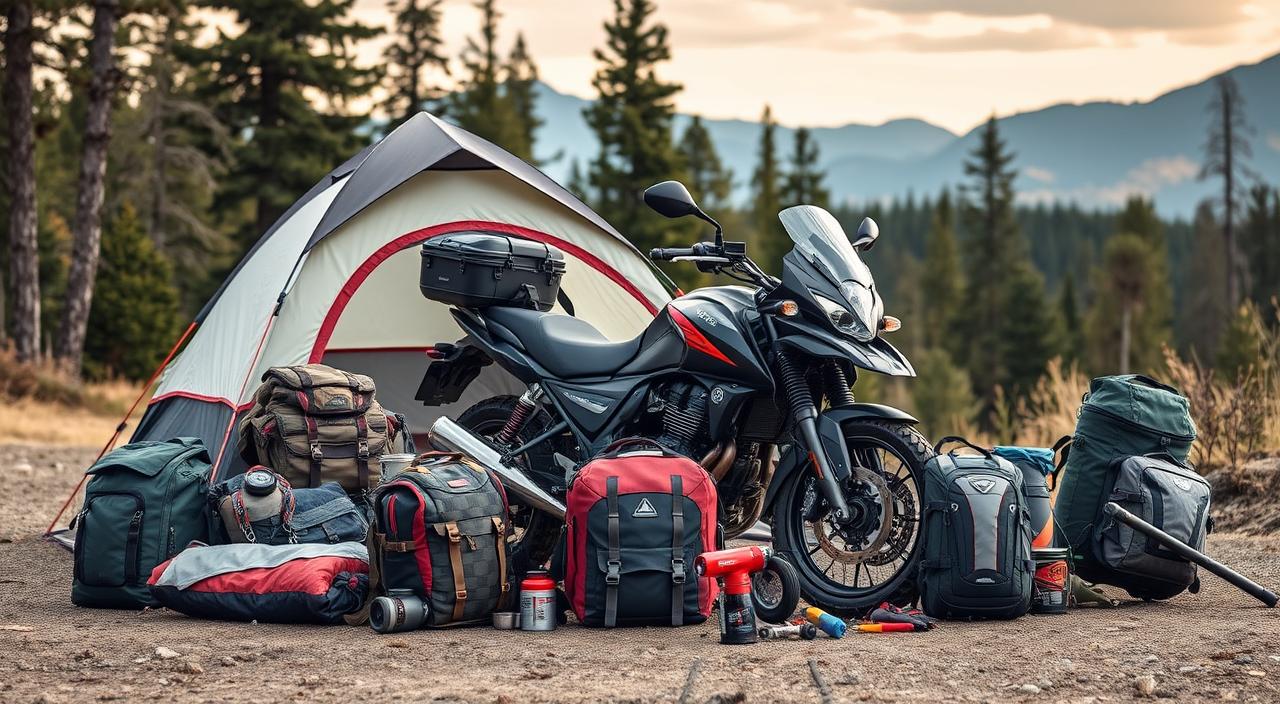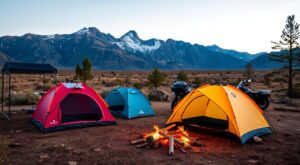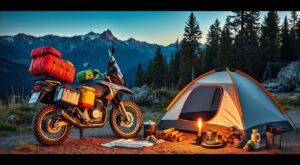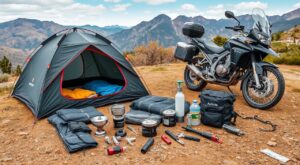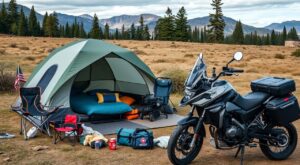Motorcycle camping mixes the excitement of riding with the joy of camping outdoors. As I prepare for my trips, I think about the key gear for motorcycle camping. This gear makes my experience better by ensuring comfort and safety. This article will talk about the must-have items, like the best tent, riding gear, and personal care items for a great motorcycle camping trip.
Key Takeaways
- Understanding the importance of prioritizing shelter options like tents and hammocks.
- Exploring various price points for camping gear, catering to all budgets.
- Considering the recommended temperature ratings for sleeping bags based on camping conditions.
- Recognizing the popularity of different cooking equipment among motorcycle campers.
- Assessing water purification methods to ensure hydration during backcountry trips.
Introduction to Motorcycle Camping
Motorcycle camping lets me explore and connect with nature while feeling the thrill of the open road. It’s perfect for both experienced campers and beginners. This adventure offers a fun way to see the outdoors without the hassle of heavy packing.
For a successful trip, planning and packing are key. I balance comfort with minimalism since I have to carry all my gear on my bike. My motorcycle camping essentials list includes light, quality gear. I focus on motorcycle camping necessities like compact tents, sleeping systems, and portable cooking gear.
Choosing the right motorcycle touring camping gear is important for safety and efficiency. I follow weight distribution tips when packing, picking smaller tents that are easy to carry. I also use three-season sleeping bags for cold nights. These choices improve my experience, letting me enjoy the ride and the adventure more.
Choosing the Right Tent for Motorcycle Camping
When I go motorcycle camping, picking the right tent is crucial for a great trip. I look for tents that are both light and compact but still comfy. Knowing about different tent types helps me pack smarter.
Types of Tents: Backpacking vs. Standard
Backpacking tents are my top choice because they’re light and easy to carry. Tents like the Copper Spur HV UL2 Bikepack Tent and the Tiger Wall UL3 Bikepack Tent are perfect for their size and strength. Standard tents are bigger but heavier, making them less ideal for motorcycle trips.
Size and Weight Considerations
For motorcycle camping, I focus on the tent’s size and weight. I prefer tents in the “Small Pack Size and Light Weight” category, like bikepacking and tarp tents. The Copper Spur HV UL Bikepack Tent is under 3 lbs and packs down to 13.5”x7”. The Blacktail Hotel Bikepack Tent is a bit heavier but has a big vestibule for gear.
Weather Resistance Features
Weather can change fast when camping, so I choose tents that can handle it. Tents made of nylon with silicone elastomer coating are great for keeping out water. Double wall designs also cut down on condensation inside. I always check for strong tent floors and rainfly for any bad weather.
| Tent Model | Weight | Packed Size | Capacity | Price |
|---|---|---|---|---|
| Copper Spur HV UL2 Bikepack Tent | Under 3 lbs | 13” x 6” | 2 Person | Approx. $599 |
| Tiger Wall UL3 Bikepack Tent | Just over 3 lbs | 13” x 7” | 3 Person | Approx. $499 |
| Blacktail Hotel Bikepack Tent | Just over 7 lbs | 14.5” x 8.5” | 2 Person | Approx. $399 |
| Kelty Late Start 2P Tent | 4.5 lbs | 16” x 7” | 2 Person | Approx. $249 |
Choosing the right tent is key for a great motorcycle camping trip. It makes sure I’m comfy no matter the weather or location. A good tent choice can really make my trip better.
Essential Gear for Motorcycle Camping
When packing for motorcycle camping, it’s important to think about the must-have gear. My list includes shelter, sleep systems, cooking gear, navigation tools, and first aid supplies. These items are key for a successful trip and help keep my bike and I safe.
Key Categories of Camping Gear
- Shelter: A light, foldable tent is a must. I choose one that fits the weather I expect.
- Sleep Systems: A 20-degree sleeping bag is good for three-season camping.
- Cooking Equipment: A portable gas stove and basic utensils let me cook outside easily.
- Water Filtration: For longer trips, a Hydrapak filter is essential for safe water.
- Navigation Tools: Maps and a GPS device help me plan my route accurately.
- First Aid Supplies: A strong first aid kit is a crucial part of any trip.
How to Prioritize Your Gear List
I start by focusing on what I need most. Shelter, sleep, and cooking gear come first. This approach helps avoid overpacking and keeps me comfortable on the bike. Packing cubes make everything easy to find and keep tidy while I’m on the move.
| Category | Must-Have Items |
|---|---|
| Shelter | Compact tent |
| Sleep Systems | 20-degree sleeping bag, sleeping pad |
| Cooking Equipment | Portable stove, cooking utensils, non-perishable food |
| Water Filtration | Hydrapak filter, reservoir bag |
| Navigation Tools | Maps, GPS device |
| First Aid Supplies | First aid kit, multi-tool |
Sleeping Systems for a Comfortable Night
Getting a good night’s sleep is key when you’re motorcycle camping. Choosing the right sleeping system can greatly improve your rest and comfort. I’ve found different sleeping bags that match various temperatures, which is crucial for my motorcycle camping gear. Investing in the right sleeping bags and accessories can change how you experience camping.
Types of Sleeping Bags and Their Ratings
Sleeping bags come in many styles and temperature ratings. For example, the Big Agnes Diamond Park series has bags for 30 degrees, 15 degrees, and 0 degrees. These ensure you stay warm and comfortable in different climates. I usually pick down or synthetic fill for their light weight, which is great for motorcyclists. It’s important to check the temperature rating to make sure you’ll be comfortable all night.
Benefits of Sleeping Pads and Inflatable Pillows
A sleeping pad adds comfort and insulation from the cold ground. Inflatable sleeping pads are my top choice because they’re light and compact. For example, the UL80 Inflatable Sleeping Pad is a great addition to my gear. Also, using an inflatable pillow can make sleeping better. The ALUFT 2.0 is a good choice because it’s compact and easy to carry, perfect for motorcycle camping.
| Sleeping Bag Type | Temperature Rating | Fill Type | Recommended Model |
|---|---|---|---|
| Down | 0, 15, 30 Degrees | Down Fill | Big Agnes Diamond Park |
| Synthetic | 0, 15, 30 Degrees | Synthetic Fill | REI Co-op Trailbreak |
| Inflatable Pad | N/A | N/A | UL80 Inflatable Sleeping Pad |
| Camping Pillow | N/A | N/A | ALUFT 2.0 Inflatable Pillow |
Cooking and Food Preparation Essentials
Starting a motorcycle camping trip means having the right cooking and food gear. It’s important to pick cooking gear that’s light and easy to carry. This makes your trip better.
Cooking Gear: Stoves, Pots, and Utensils
For motorcycle campers, a portable stove is a must. Jetboil and MSR make great options that are easy to carry and quick to use. I like cookware sets made from strong materials like titanium or aluminum. They’re light but still work well.
Don’t forget utensils, plates, and containers. I use reusable silicone bags and airtight containers to keep food fresh and organized.
Food Options: Dehydrated Meals and Snacks
Keeping meals simple is best for camping. I often make meals that are easy to cook with few ingredients. For breakfast, oatmeal with dried fruits and nuts or scrambled eggs with pre-cooked bacon are great choices.
Lunch can be sandwiches with cheese and cured meats or a quinoa salad. Dinner is easy with one-pot meals like chili, pasta, or stir-fry using instant rice. I also pack snacks like trail mix, beef jerky, and energy bars for energy on the road.
Water Needs: Hydration and Filtration Solutions
Drinking enough water is crucial on a camping trip. A portable water filtration system lets me make clean water from any source. This keeps me hydrated and gives me energy for the trip.
With the right cooking and food gear, camping becomes more fun and builds friendships with other travelers.
Navigating the Great Outdoors
When you’re planning motorcycle camping trips, getting your route right is key. I’ve found that using both traditional maps and modern GPS is best. This way, I have reliable tools for finding my way. Planning your route ahead of time helps you see the best scenery and avoid long detours. But, in remote places, GPS alone might not be enough. That’s why learning to use a map and compass is crucial.
Navigation Tools: Maps vs. GPS Devices
Maps and GPS devices each have their own benefits. Here’s how they stack up as must-have gear for motorcycle camping:
| Navigation Tool | Advantages | Disadvantages |
|---|---|---|
| Maps |
|
|
| GPS Devices |
|
|
Planning Your Route Before You Leave
Planning your route well can make your trip better. I make detailed plans that include interesting spots and places to camp. Here are some tips to help you plan your motorcycle camping trips:
- Identify key waypoints along your route.
- Research and evaluate potential camping locations.
- Account for fuel stops and rest breaks.
- Consider alternate routes for flexibility.
- Ensure you have adequate food and water supplies for the journey.
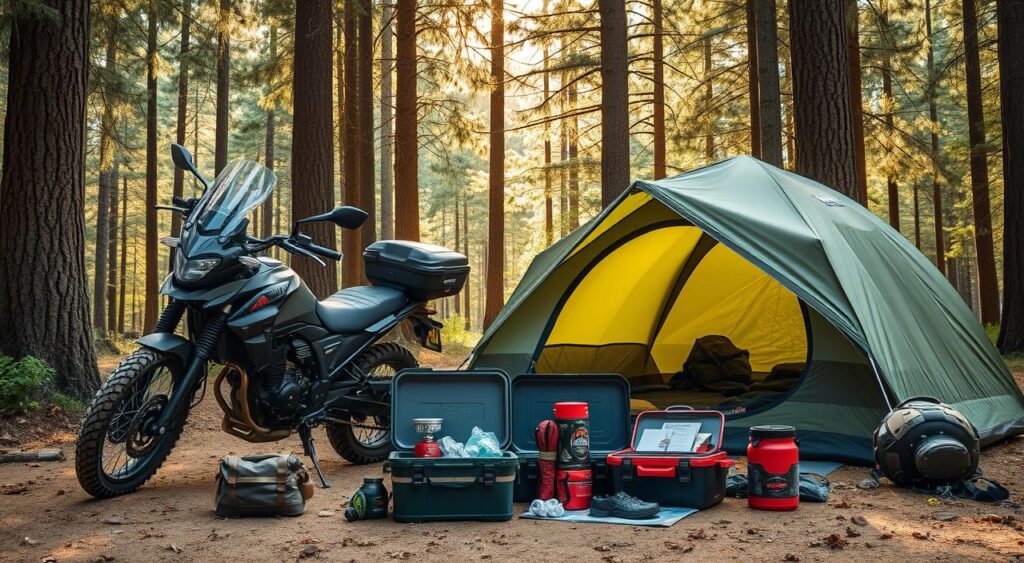
First Aid and Safety Supplies
Getting ready for a motorcycle camping trip means thinking about safety and first aid. Having the right gear can turn a small problem into a big one. A good first aid kit is a key item for motorcycle camping. It should have bandages, antiseptic wipes, pain relievers, and your personal medicines. This way, you’re prepared for any medical issues and can enjoy the outdoors more.
Importance of a Robust First Aid Kit
A strong first aid kit is a must for motorcycle camping. You should pack things like adhesive bandages, gauze, cotton balls, hydrogen peroxide, and painkillers. These items are vital for treating injuries quickly and keeping me safe in remote areas.
Must-Have Safety Items for Your Trip
Along with a first aid kit, there are other safety items you need for camping. A multi-tool is great for quick repairs, and a flashlight helps with nighttime activities. Bug repellent keeps pests away, and a strong lock secures my motorcycle, preventing theft while I enjoy my trip.
Clothes and Personal Care Gear
When you go motorcycle camping, picking the right clothes and personal care items is key. My motorcycle camping essentials list focuses on layering to handle the weather changes. This keeps me comfy and safe on my trip.
Layering for Variable Weather Conditions
Layering is a must for essential items for motorcycle campers. I make sure to pack:
- Breathable base layers that wick moisture
- Insulating mid-layers such as fleeces or down jackets
- A waterproof outer jacket to shield against rain and wind
- Extra socks and underwear for hygiene on multi-day trips
This way, I can adjust my clothes as the weather changes. It’s important for a camping trip.
Toiletries and Hygiene Essentials
Keeping clean is important while camping, so I bring necessary toiletries. My list includes:
- Travel-sized shampoo, soap, and toothpaste
- Sunscreen to protect against harmful UV rays
- Insect repellent to ward off pesky bugs
- A packable camp towel for drying off after washing
These camping gear for motorcycle trips make me more comfortable and keep me healthy outdoors.
| Item | Purpose | Notes |
|---|---|---|
| Base Layers | Moisture-wicking | Regulates body temperature |
| Mid-layers | Insulation | Helps retain warmth |
| Outer Jacket | Weather protection | Waterproof and windproof |
| Extra Socks | Comfort and hygiene | Prevents blisters |
| Travel Toiletries | Personal hygiene | Compact and easy to carry |
| Sunscreen | Skin protection | SPF 30 or higher recommended |
| Insect Repellent | Bite prevention | Use DEET for efficacy |
| Camp Towel | Drying off | Quick-drying and lightweight |
Riding Essentials: Gear for the Journey
When I get ready for a motorcycle camping trip, I focus on the must-haves for safety and smooth riding. Tools like a flat tire repair kit and spare fuses are key. They can save the day on the road. Having these items makes me feel more secure and ready for anything.
Maintenance and Repair Kits for Your Motorcycle
Here are some important things to pack for my motorcycle:
- Flat tire repair kit
- Essential tools (screwdrivers, wrenches, pliers)
- Spare fuses and bulbs
- Chain lube and cleaner
- Basic first aid kit
These items help me fix unexpected problems on the go. Having the right gear is a must for motorcycle camping.
Safety Gear: Helmet, Jacket, and Protective Clothing
High-quality safety gear is a must for every ride. My go-to gear includes:
- A well-fitted helmet
- Durable riding jacket with armor
- Protective riding pants
- Sturdy riding boots
This gear keeps me safe from the weather and road dangers. It’s not just about following the rules; it lets me enjoy the ride without worry.
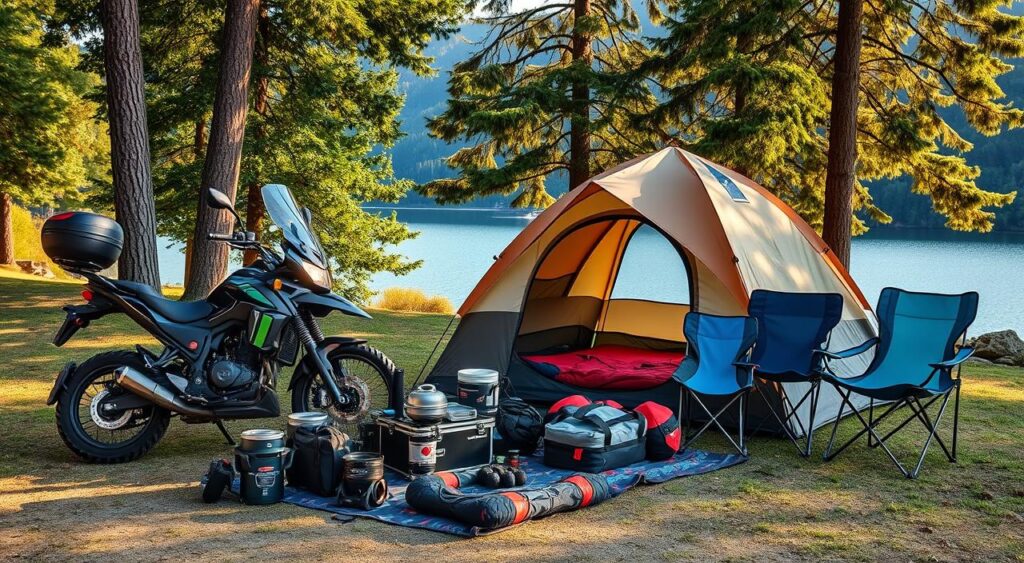
Camping Comfort: Extras to Enhance Your Trip
When I go motorcycle camping, I make sure to pack extra items for comfort. These extras make my trips much better. They include reliable light sources and bug protection.
Light Sources: Flashlights and Headlamps
Being ready for the dark is key. I always bring a flashlight or headlamp. They help me see when it’s dark at the campsite.
Whether I’m setting up my tent or cooking, a good light is essential. It lets me do tasks without tripping. These are must-haves that make nights under the stars more enjoyable.
Bug Protection and Sun Safety
Keeping bugs away is important for me. I use bug spray to keep insects off. I also use sunscreen to protect my skin from the sun.
These items keep me comfortable and focused on enjoying my trip. They help me make the most of my time outdoors.
| Camping Comfort Extras | Description |
|---|---|
| Flashlight | Compact and lightweight, perfect for navigating in the dark. |
| Headlamp | Hands-free light source ideal for cooking and setting up tents. |
| Bug Spray | Protects against mosquitoes and other annoying insects. |
| Sunscreen | Shields skin from UV rays during daytime activities. |
How to Pack for Your Motorcycle Camping Trip
Packing for a motorcycle camping trip means planning carefully. You have limited space, so you need to pack smart. This way, you save space and keep your gear in order. It also helps you not forget anything important.
Efficient Packing Techniques for Limited Space
Using motorcycle panniers for heavy items is a great tip. They help spread the weight evenly, making your bike more stable. A tank bag is perfect for carrying valuables and things you use often, like your phone or wallet.
For emergency repairs, a tool roll is a must. It keeps your tools organized. Roll bags are great for soft, bulky items like sleeping bags and tents.
Working with a travel partner can make packing easier. You can share your gear lists to avoid duplicates. Start with basic camping gear and upgrade as needed. Use compression bags for clothes and special bags for cables, shoes, and food. This method saves space and makes finding things easier on the road.
Utilizing Saddlebags and Dry Bags Effectively
To keep your gear dry, use dry bags. They protect your items from water damage, which is key on a motorcycle trip. I prefer rokstraps over bungees for better stability on long rides.
Tool tubes are great for organizing your gear. You can attach them to your bike for easy access to tools or other items. Always carry enough water and food for your trip, like a gallon of water per person and three days’ food.
Here’s a list of what I always pack for motorcycle camping:
| Category | Items |
|---|---|
| Camping Gear | Tent, sleeping bag, fire-starting kit |
| Cooking Supplies | Camping stove, fuel, dishes, utensils |
| Clothing | Riding outfit, weather-appropriate clothing |
| Personal Care | First aid kit, toiletries, sunscreen |
| Safety & Tools | Lock (disc lock), multi-tool, flat kit |
| Navigation | GPS, maps, compass |
This checklist makes sure I have everything I need for motorcycle camping. It keeps my gear organized and ready for adventure.
Conclusion
Getting ready for a motorcycle camping trip should be exciting, not stressful. It’s all about embracing adventure. With the right gear, like a quality tent and a UL80 Inflatable Sleeping Pad, I’m set for great rest.
Having must-have accessories, like a first-aid kit and cooking gear, shows the value of planning. I pack enough food and water for three days and a gallon per person. This keeps me energized. Plus, packing smart helps me ride comfortably and keeps my gear safe.
Motorcycle camping lets me see beautiful places and connect more with my bike. With the right gear and planning, the road ahead is full of joy and unforgettable moments in nature.
